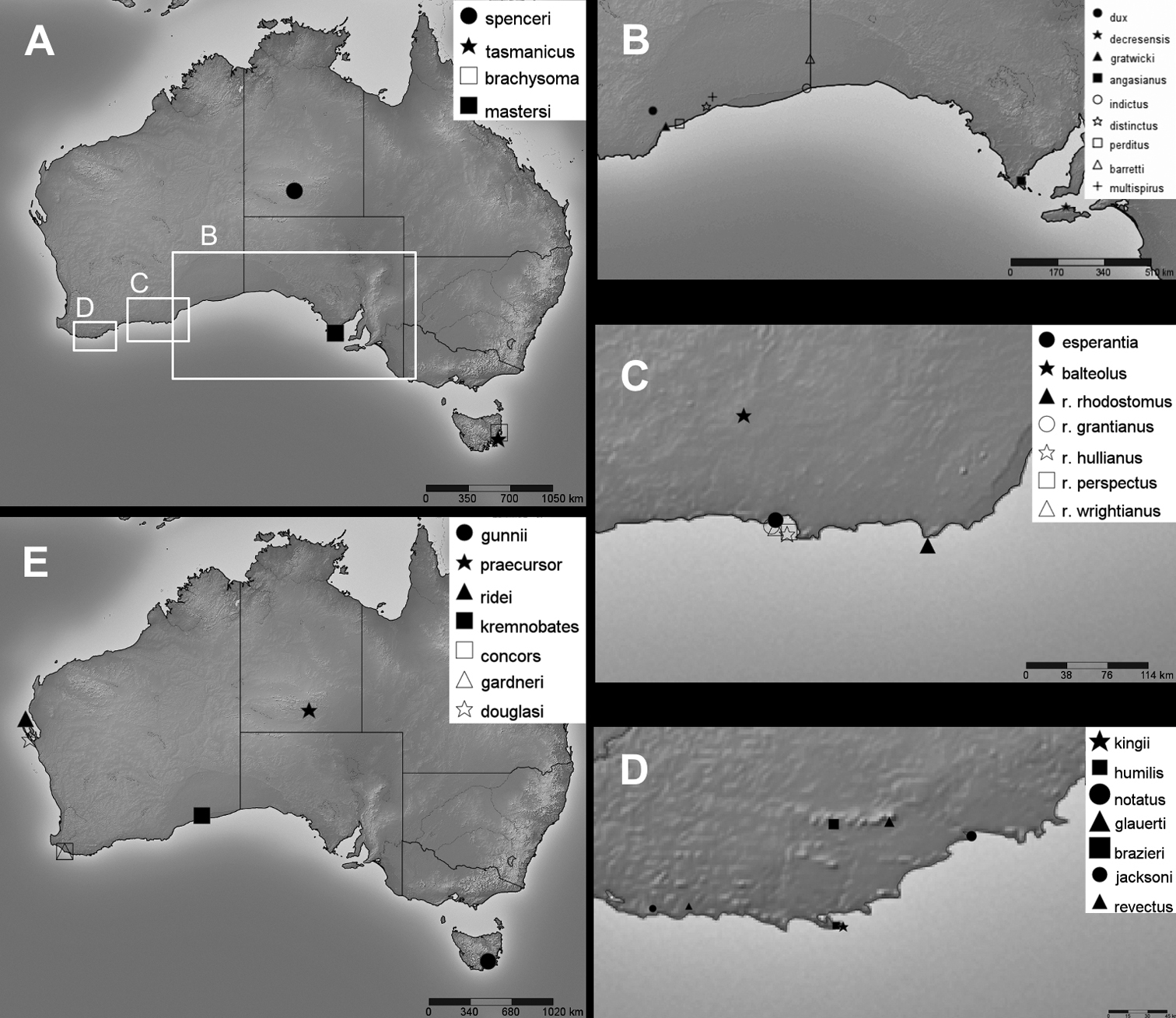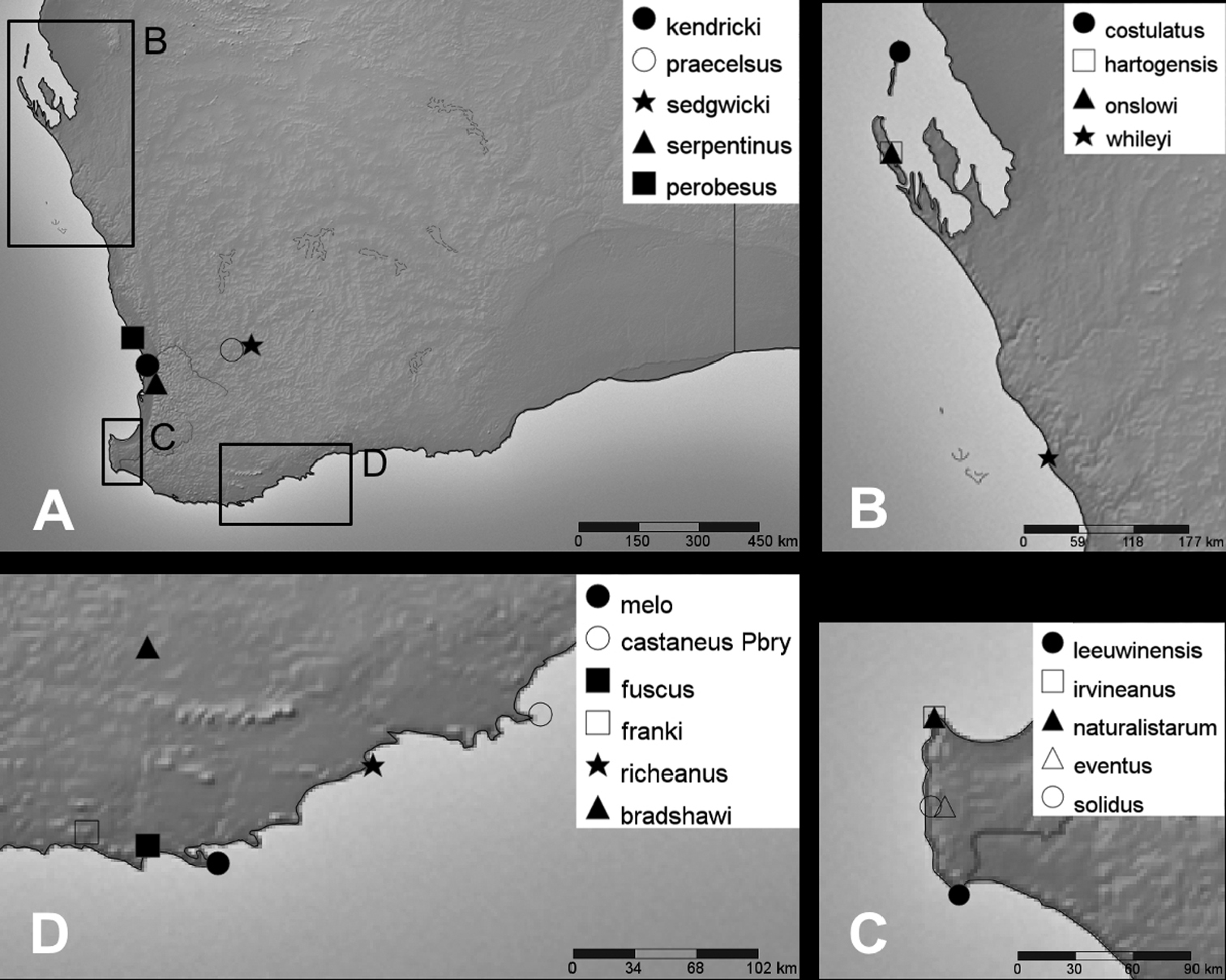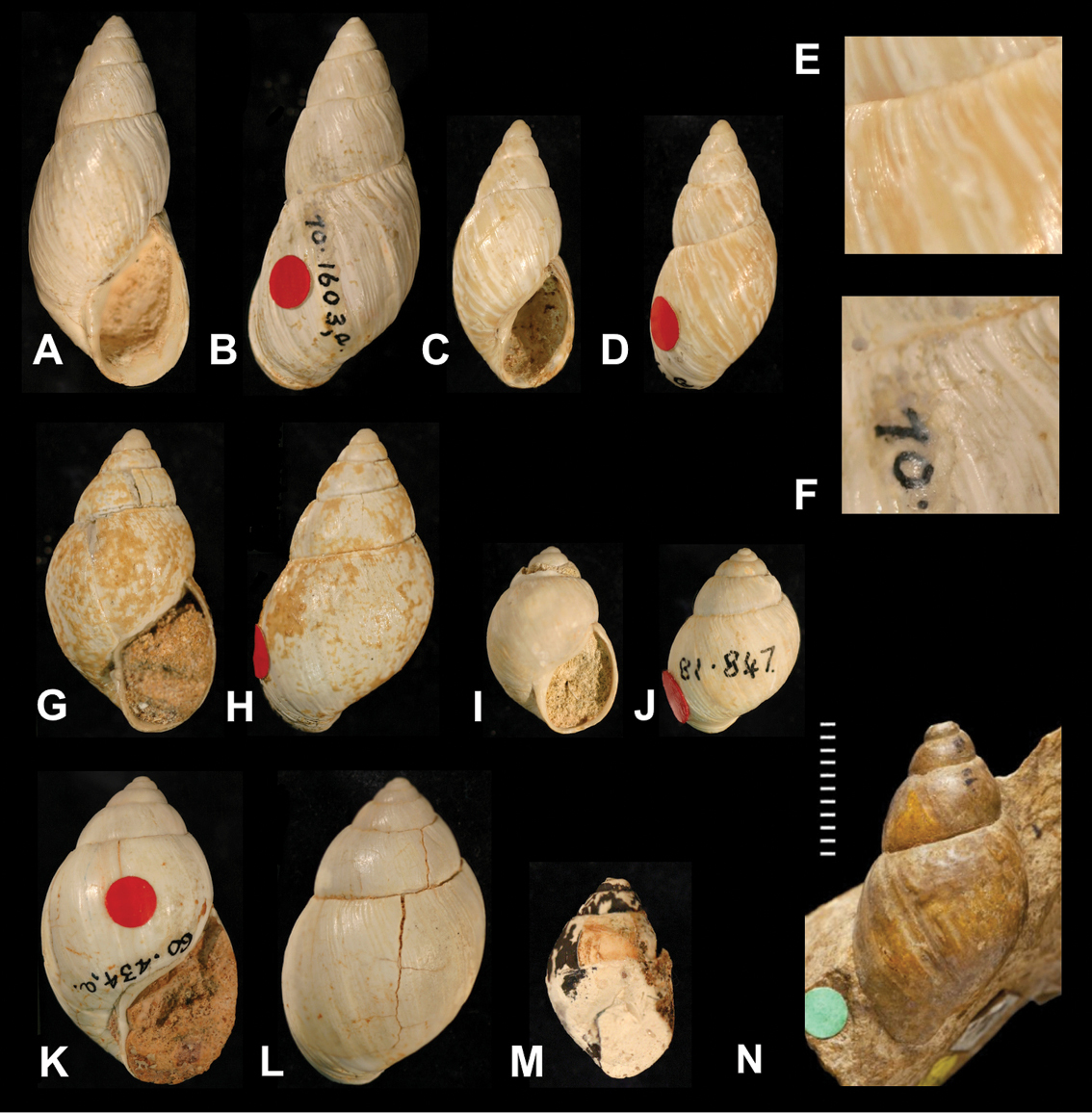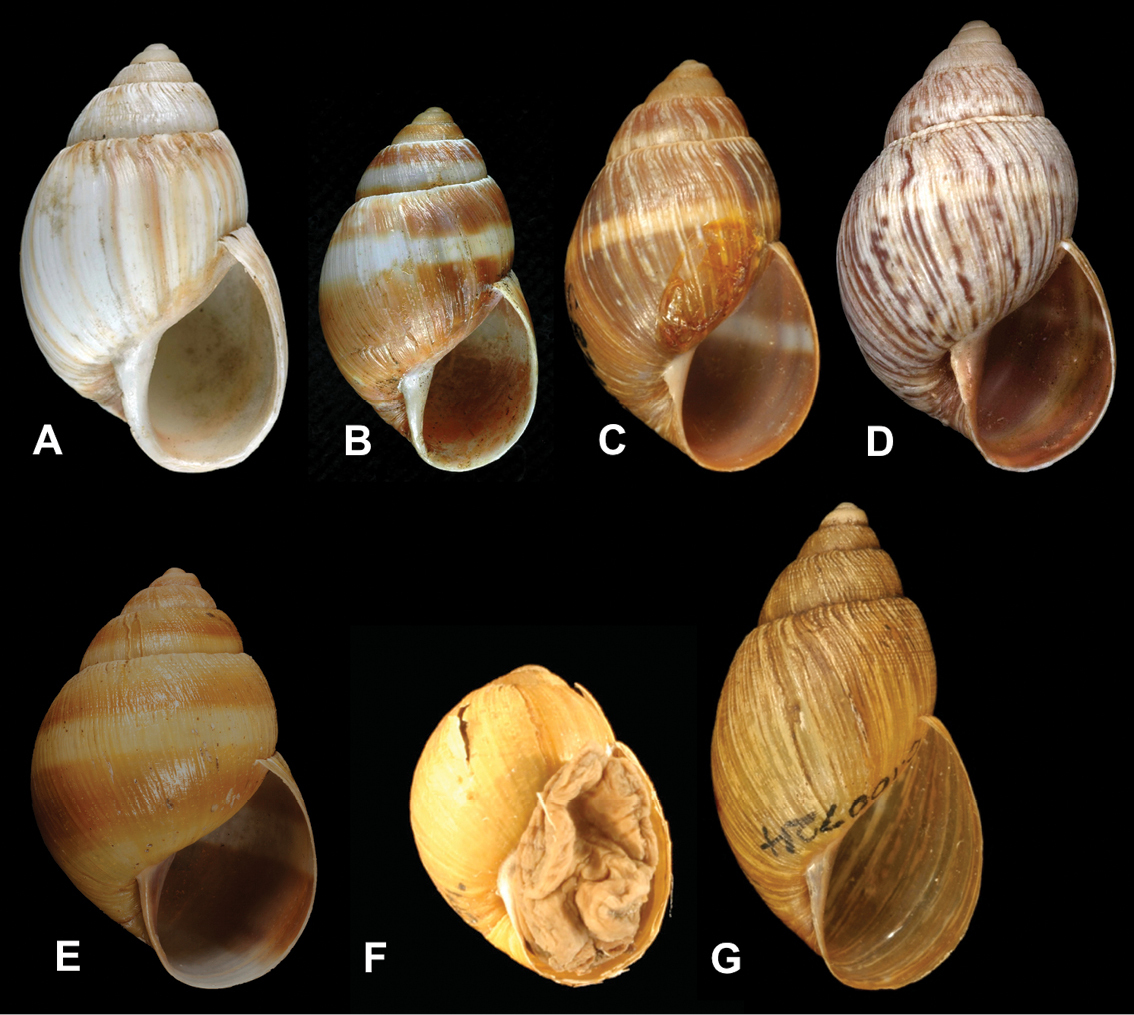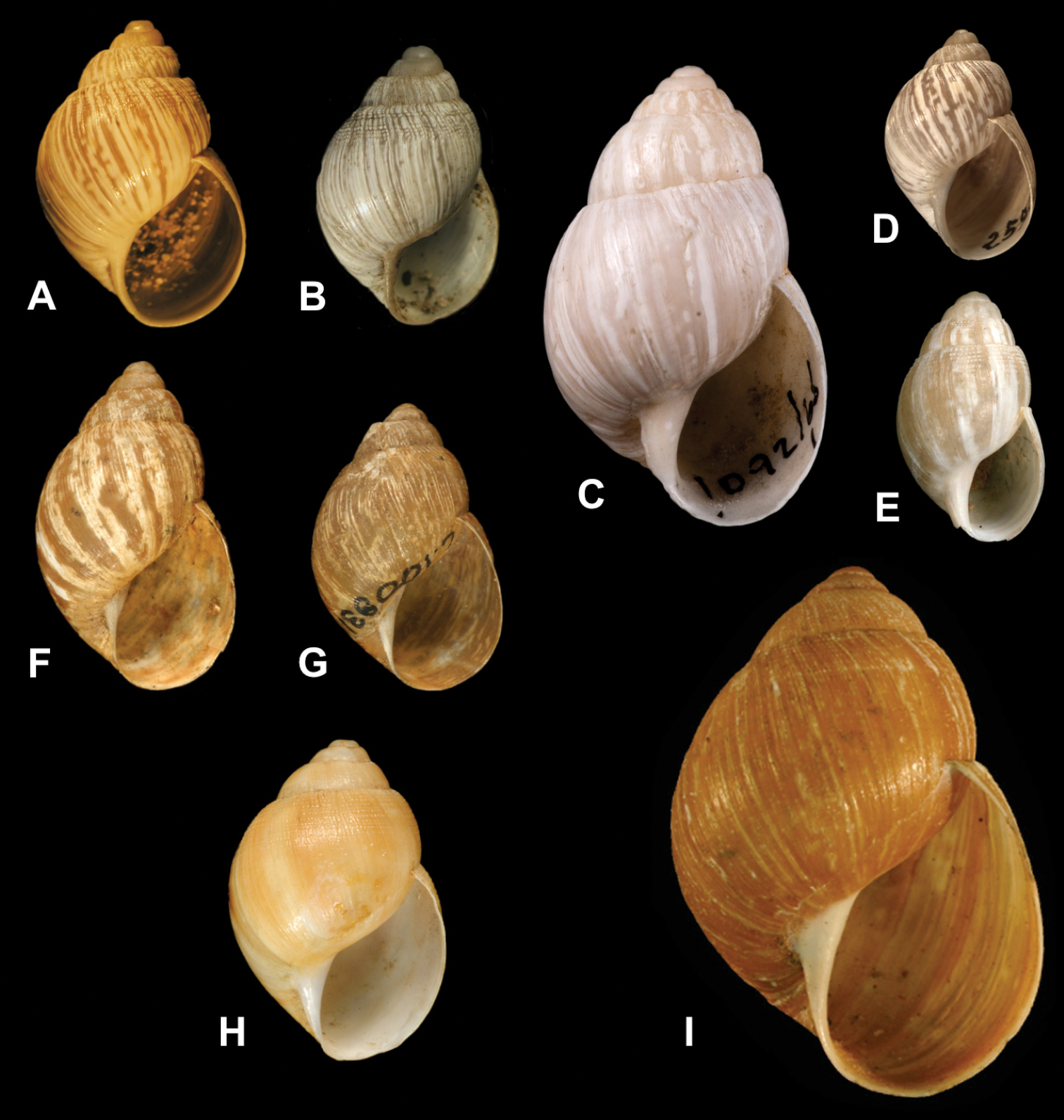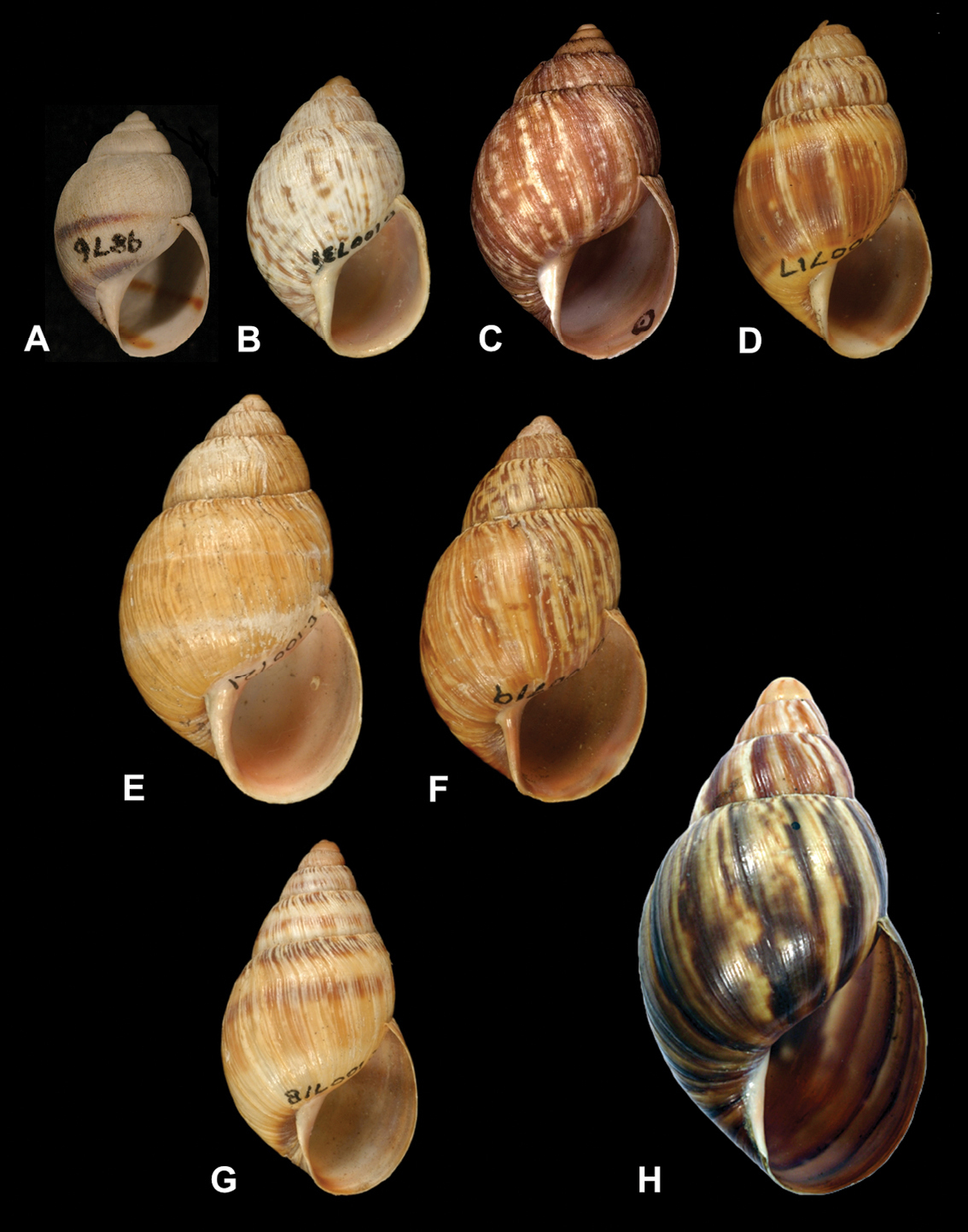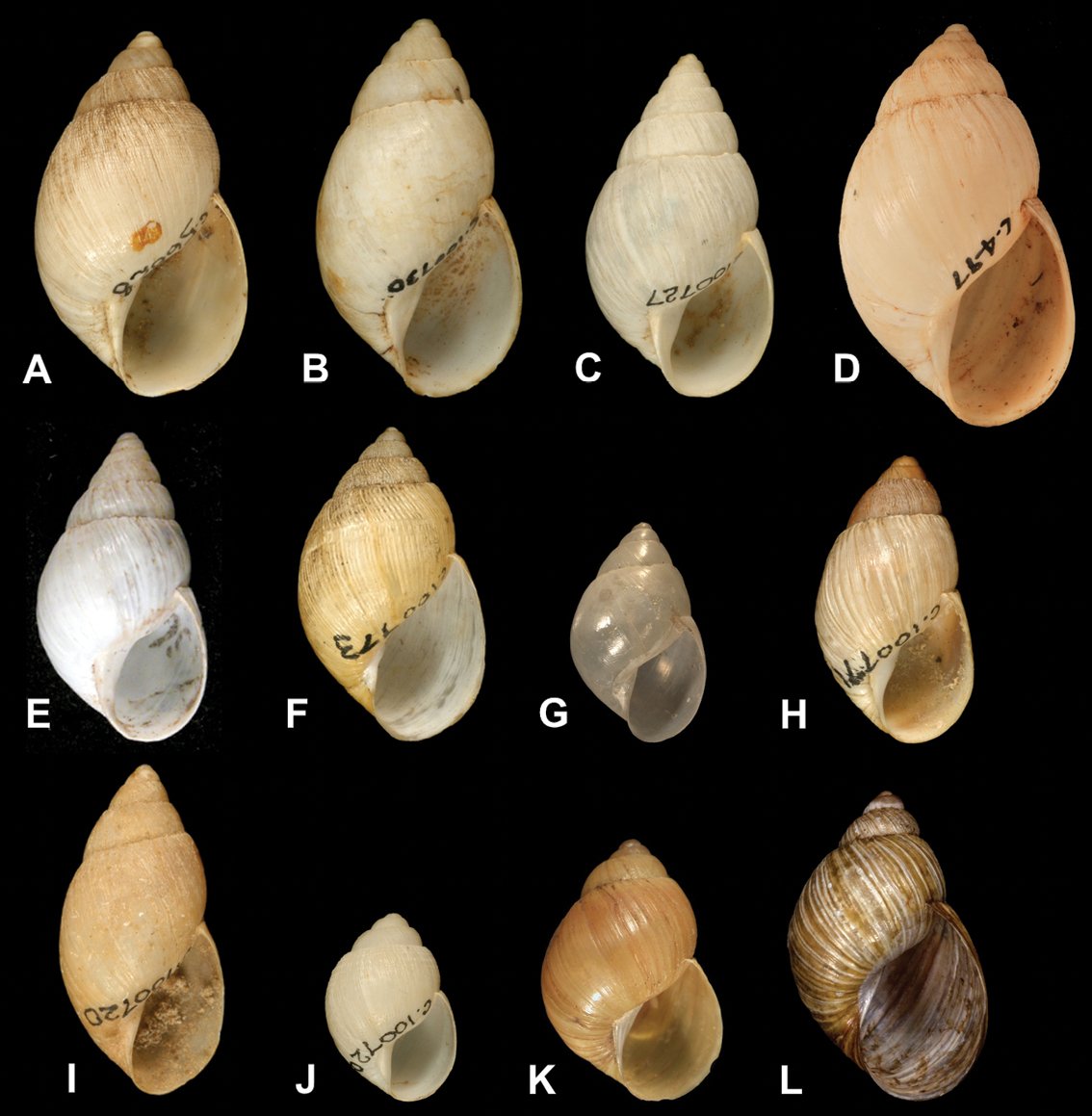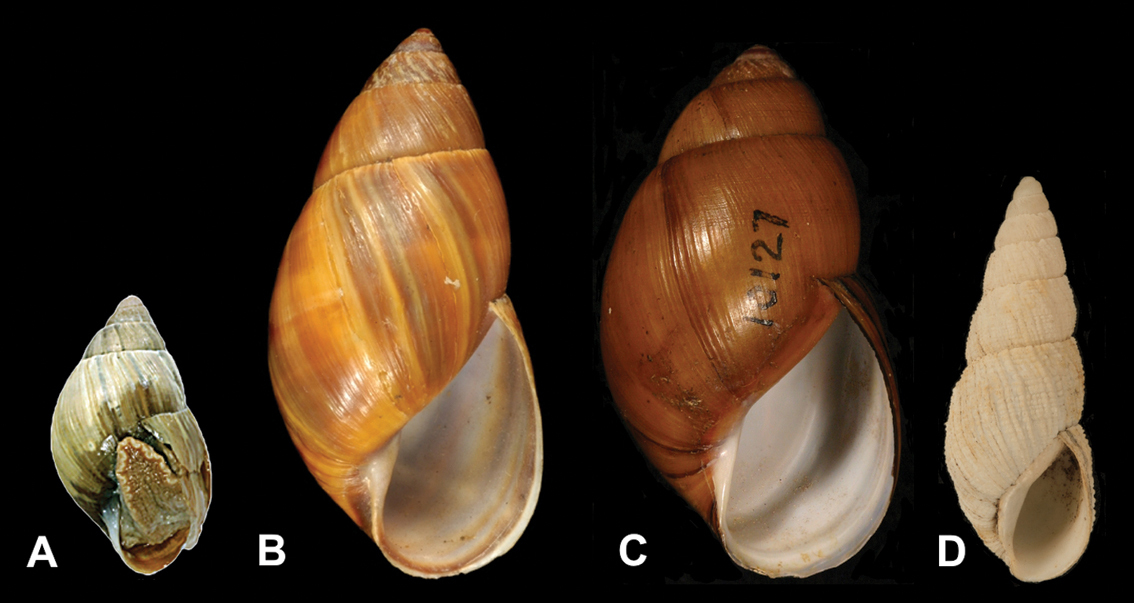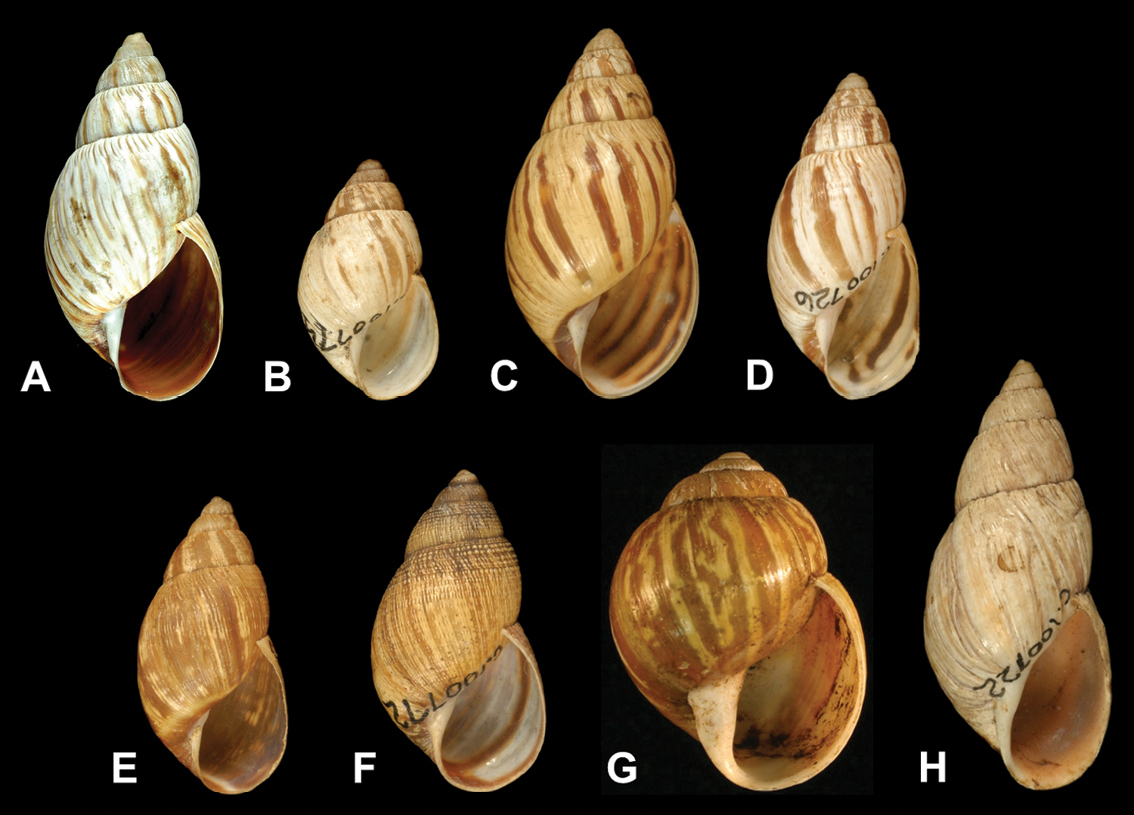






(C) 2012 Abraham S.H. Breure. This is an open access article distributed under the terms of the Creative Commons Attribution License 3.0 (CC-BY), which permits unrestricted use, distribution, and reproduction in any medium, provided the original author and source are credited.
For reference, use of the paginated PDF or printed version of this article is recommended.
Type material of 41 Australian Bothriembryon taxa present in Australian museums is critically listed, indicating systematic issues that need to be resolved in further studies. Information on additional type material of 22 taxa in non-Australian museums is compiled. The seven fossil taxa known so far are included in this catalogue. Based on the current systematic position, 38 species are treated in this paper. Bothriembryon jacksoni Iredale, 1939, Bothriembryon notatus Iredale, 1939, Bothriembryon praecelsus Iredale, 1939 and Bothriembryon serpentinus Iredale, 1939 are elevated to species level. Bothriembryon gratwicki (Cox, 1899) is listed as status to be determined.
Australia, Bothriembryontidae, types
The land snail genus Bothriembryon Pilsbry, 1894, is endemic to Australia but forms part of the Gondwanan element in the superfamily Orthalicoidea. This genus has received little in-depth attention, the last review being B.J.
For each taxon the original publication—in which the taxon was proposed—is mentioned, as well as papers in which reference is made to the type material. The type locality is quoted from the original publication in the original wording and language, with clarifying notes between square brackets. These localities have been mapped using SimpleMappr (
Abbreviations used for depositories of material are: AM, Australian Museum, Sydney, Australia; ANSP, Academy of Natural Sciences, Philadelphia, USA; CPC, Geoscience Australia, Canberra, Australia; MHNG, Muséum d’Histoire Naturelle, Genève, Switzerland; MNHN, Muséum National d’Histoire Naturelle, Paris, France; MV, Museum of Victoria, Melbourne, Australia; NHMUK, Natural History Museum, London, U.K.; SAMA, South Australian Museum, Adelaide, Australia; SMF, Senckenberg Natur-Museum, Frankfurt am Main, Germany; TWCMS, Great Northern Museum (formerly Hancock Museum), Newcastle-upon-Tyne, U.K.; UMZC, University Museum of Zoology, Cambridge, U.K.; WAM, Western Australian Museum, Perth, Australia; ZMB, Museum für Naturkunde, Humboldt-Universität, Berlin, Germany. Other abbreviations used are: D, shell diameter; H, shell height; W, number of whorls. This paper follows the structure of Breure (2011) and
Systematic list of nominal taxa of Bothriembryon in Australian museums
Fossil taxa are indicated with an asterisk (*).
Family Bothriembryontidae Iredale, 1939Remarks. This genus was hitherto classified with the Bulimulidae (
Bothriembryon Pilsbry, 1894
Bothriembryon balteolus Iredale, 1939; Bothriembryon barretti Iredale, 1930; Bothriembryon bradshawi Iredale, 1939; *Bothriembryon consors Kendrick, 1978; Bothriembryon distinctus Iredale, 1939; *Bothriembryon douglasi Kendrick, 1978; Bothriembryon esperantia Iredale, 1939; Bothriembryon eventus Iredale, 1939; Bothriembryon franki Iredale, 1939; *Bothriembryon gardneri Kendrick, 1978; Bothriembryon glauerti Iredale, 1939; Bothriembryon grantianus Iredale, 1939; Bothriembryon gratwicki (Cox, 1899); Bothriembryon hullianus Iredale, 1939; Bothriembryon humilis Pilsbry, 1900; Bothriembryon indictus Iredale, 1939; Bothriembryon irvineanus Iredale, 1939; Bothriembryon jacksoni Iredale, 1939; Bothriembryon kendricki Hill, Johnson & Merrifield, 1983; *Bothriembryon kremnobates Kendrick, 2005; Bothriembryon notatus Iredale, 1939; Bothriembryon perditus Iredale, 1939; Bothriembryon perobesus Iredale, 1939; Bothriembryon perspectus Iredale, 1939; Bothriembryon praecelsus Iredale, 1939; *Bothriembryon praecursor McMichael, 1968; Bothriembryon revectus Iredale, 1939; Bothriembryon richeanus Iredale, 1939; *Bothriembryon ridei Kendrick, 1978; Bothriembryon sedgwicki Iredale, 1939; Bothriembryon serpentinus Iredale, 1939; Bothriembryon solidus Pilsbry, 1900; Bothriembryon whitleyi Iredale, 1939; Bothriembryon wrightianus Iredale, 1939.
Alphabetic list of taxa by species namehttp://species-id.net/wiki/Bothriembryon_balteolus
Fig. 6A[Western Australia] “Esperance Mallee Belt district, 50 miles south of Norseman, Madura, Salmon Gums”.
“Mallee belt / Esperance / WA”.
“length 21 mm, breadth 15 mm”; lectotype H 21.5, D 13.6, W 5.0.
WAM S15154, lectotype; AM C100716, paralectotype; AM C127557, three paralectotypes; AM C127558, two paralectotypes; WAM S15151, nine paralectotypes; WAM S15152, two paralectotypes; WAM S15153, two paralectotypes.
Wells (1977: 52) designated specimen WAM 9876 (now WAM S15154) as lectotype. Iredale’s description was based on “Many shells...”.
Bothriembryontidae, Bothriembryon balteolus Iredale, 1939.
http://species-id.net/wiki/Bothriembryon_barretti
Fig. 7A[South Australia] “Nullabor Plain”.
“Nullabor Plains” “near Hampton / WA / fide
“length, 27 mm; breadth, 15.5 mm”; figured specimen H 28.1, D 16.5, W 5.3.
AM C56628, two syntypes, C. Barrett leg.
The additional label information “near Hampton” (see also
Bothriembryontidae, Bothriembryon barretti Iredale, 1930.
http://species-id.net/wiki/Bothriembryon_bradshawi
Fig. 5F[Western Australia] “Tambellup”.
“Tambellup / WA”.
“Length, 19.5 mm., breadth, 12 mm”; figured specimen H 19.0, D 11.4, W 4.7.
AM C100749, syntype; AM C59096, nine syntypes; AM C59208, 30+ syntypes; WAM S15148, four syntypes; WAM S15149, two syntypes; WAM S15150, one syntype (all ex E.R. Bradshaw).
Iredale’s description is based on “A good series” of shells. According to
Bothriembryontidae, Bothriembryon bradshawi Iredale, 1939.
http://species-id.net/wiki/Bothriembryon_inflatus_castaneus
Fig. 4C[Western Australia] “Recherche Archipelago (Dr. Cox)”. See Remarks.
“Reserch [sic] / Archipelago / W. Australia”.
“Alt. 22, diam. 13 (...) mill.”; figured specimen H 23.1, D 13.8, W 5.1.
AM C87458, syntype (Cox coll.).
Bothriembryontidae, Bothriembryon melo (Quoy and Gaimard, 1832).
http://species-id.net/wiki/Bothriembryon_consors
Figs 3C–E“Windy Harbour, Western Australia. Shallow quarry NE of lighthouse beside track to Salmon Bay. Lat. 34°49'14"S, long. 116°00'52"E. Probably Pleistocene age. See Remarks.
“Windy Harbour, W.A. Shallow / quarry NE of lighthouse beside track / to Salmon Beach”, in Kendrick’s handwriting.
“height of 29.9 mm, maximum diameter 13.8 mm”; holotype H 30.0, D 13.6, W 5.3.
WAM 72421a, holotype; WAM 72421b–e, j and k, 70901a–b, 70160d, nine paratypes.
Although the formulation differs, this is the same locality where Bothriembryon gardneri Kendrick, 1978 has been found.
Bothriembryontidae, Bothriembryon consors Kendrick, 1978.
http://species-id.net/wiki/Bothriembryon_decresensis
Fig. 5B[South Australia] “Cape Cassini, Kangaroo Island”.
“Cape Cassini / K.I.”
“height 16 mm., width 10 mm”; holotype H 15.5, D 10.37, W 4.7 .
SAMA D13773, holotype; SAMA D15588, 26 paratypes.
We tentatively follow the opinion of B.J.
Bothriembryontidae, Bothriembryon mastersi (Cox, 1867).
http://species-id.net/wiki/Bothriembryon_distinctus
Fig. 7C[Western Australia] “Cardanumbi, west of Eyre”.
“Cardanumbi / WA”.
“length of the type 27 mm., breadth 15.5 mm”; figured specimen H 26.3, D 14.5, W 6.5.
AM C100727, syntype; AM C127568, three syntypes; WAM S15147, seven syntypes.
Bothriembryontidae, Bothriembryon barretti Iredale, 1930.
http://species-id.net/wiki/Bothriembryon_douglasi
Figs 3G–H“Sea cliff at the Carrarang-Tamala boundary fence, Edel Land, Shark Bay, Western Australia. Lat. 26°32'26"S, long. 113°26'42"E.
“Sea cliff at the Carrarang- / Tamala boundary fence, Edel Land / from top 25 feet / (7.5 m) of the cliff”, in Kendrick’s handwriting.
“height of 34.2 mm, maximum diameter 19.6 mm”; holotype H 34.2, D 19.1, W 5.7.
WAM 661036a, holotype; 661036b–c, 681434c, d, g, j, and o, seven paratypes. All material B.R. Wilson and G.W. Kendrick leg., 4.iii.1966.
Bothriembryontidae, Bothriembryon douglasi Kendrick, 1978.
http://species-id.net/wiki/Bothriembryon_esperantia
Fig. 6B[Western Australia] “Esperance”.
“Esperance / WA”.
“Length 23 mm., breadth 15 mm”; figured specimen H 23.9, D 15.0, W 5.2.
AM C48681, 40+ syntypes; AM C100731, syntype; MV F333, 36 syntypes; MV F26930, four syntypes; WAM S15146, four syntypes.
Iredale gives two sets of measurements (“The largest measures 26 mm. by 16 mm.”), but does not mention the total number of specimens he examined.
Bothriembryontidae, Bothriembryon esperantia Iredale, 1939.
http://species-id.net/wiki/Bothriembryon_leeuwinensis_eventus
Fig. 7H[Western Australia] “Margaret River”.
“Margaret River / SWA”.
“the type measuring 23 mm. in length by 14 mm. in breadth”; figured specimen H 22.0, D 12.2, W 4.9.
AM C100771, syntype; AM C127657, three syntypes; WAM S15124, 11 syntypes.
Bothriembryontidae, Bothriembryon leeuwinensis (E.A. Smith, 1894).
http://species-id.net/wiki/Bothriembryon_franki
Fig. 8B[Western Australia] “Denmark”.
“Denmark / Deep River / WA”.
“Length 40 mm., breadth 21 mm.”; figured specimen H 40.0, D 19.6, W 5.2.
AM C100728, syntype; AM C127672, 35 syntypes; MV F3332, nine syntypes; MV F26911, four syntypes; WAM S15145, six syntypes.
The text in
Bothriembryontidae, Bothriembryon fuscus Thiele, 1930.
http://species-id.net/wiki/Bothriembryon_gardneri
Figs 3A–B, F“Point d’Entrecasteaux, Western Australia. Shallow quarry on crest of low ridge of calcarenite on north side of track from Windy Harbour to Salmon Beach. Lat. 34°49'14"S, long. 116°00'52" E“. Probably of Pleistocene age. See Remarks.
“Pt d’Entrecasteaux, WA. / Shallow quarry on low ridge, N side of / track from Windy Harbour to Salmon Beach”, in Kendrick’s handwriting.
“height of 43.5 mm, maximum diamter 19.5 mm”; holotype H 43.5, D 18.4, W 5.8
WAM 701603a, syntype; 701603b–c, 66794a–b, 66798a, h and w, seven syntypes; FMNH 194694/3, three paratypes. All material G. Gardner, J.K. Penglase, G.W. Kendrick leg, 1.viii.1970.
Although the formulation differs, this is the same locality where Bothriembryon consors Kendrick, 1978 has been found.
Bothriembryontidae, Bothriembryon gardneri Kendrick, 1978
http://species-id.net/wiki/Bothriembryon_glauerti
Fig. 8C[Western Australia] “Stirling Ranges”.
“Stirling Range” (see Remarks).
“The type measures 38 mm. in length by 22 mm. in breadth”; figured specimen H 36.7, D 20.8, W 5.5.
WAM S14466, syntype; WAM S15144, three syntypes, F.R. Bradshaw leg.
According to the old WAM registration book (No. 10127) this material was collected by F.R. Bradshaw at Bluff Knoll. This more specific locality was not mentioned by
Bothriembryontidae, Bothriembryon glauerti Iredale, 1939.
http://species-id.net/wiki/Bothriembryon_rhodostomus_grantianus
Fig. 6E[Western Australia, Recherche Archipelago] “Charley Island”.
“Charley I / Recherche Arch’o / WA”, “?Type / (?measurements) / Fig’d Spem”.
“length, 40 mm. by breadth, 20 mm.”; figured specimen H 36.5, D 21.2, W 5.5.
AM C100721, syntype; WAM S15118, four syntypes, A.F. Basset Hull leg., 1921.
The AM label indicates that this is the specimen figured by Iredale, but shows doubt about the status of the specimen.
Bothriembryontidae, Bothriembryon rhodostomus (Gray, 1834).
http://species-id.net/wiki/Bulimus_gratwicki
Fig. 8D“About 50 miles east of Israelite Bay, Western Australia, two miles from the edge of the cliffs”.
“50 miles E of / Israelite Bay / WA”, taxon label in Cox’ handwriting. See Remarks.
“Length 30 mm. Width about the middle of the body whorl 10 mm”; holotype H 29.5, D 10.3, W 7.4.
AM C6376, two syntypes; AM C127559, eight syntypes (ex Cox coll.).
According to B.J.
Status to be determined.
http://species-id.net/wiki/Bothriembryon_rhodostomus_hullianus
Fig. 6G[Western Australia, Recherche Archipelago] “Gunton Island”.
“Gunton I / Recherche Arch’o / WA”.
“35 mm. in length by 18 mm. in breadth”; figured specimen H 31.7, D 18.3, W 6.0.
AM C100718, syntype; WAM S15116, four syntypes, A.F. Basset Hull leg., 1921.
The AM specimen is labelled “holotype” (not in Iredale’s but in McMichael’s hand), but does not confirm with the original measurements; moreover,
Bothriembryontidae, Bothriembryon rhodostomus (Gray, 1834).
http://species-id.net/wiki/Bothriembryon_physoides_humilis
Fig. 9B“Western Australia, King George Sound”.
“King George Sound”.
“Alt. 17.5, diam. 10 (...) mill.”; lectotype H 17.2, D 10.1, W 4.8.
AM C100774, lectotype; AM C1062, two paralectotypes; ANSP 65568, two paralectotypes (dry) and three bodies (alcohol).
In his original description,
Current systematic position. Bothriembryontidae, Bothriembryon kingii (Gray, 1825).
http://species-id.net/wiki/Bothriembryon_barretti_indictus
Fig. 7B[Western Australia] “Eucla”.
“Eucla / SWA”.
“30 mm. in length by 15 mm. in width”; figured specimen H 28.8, D 15.6, W 5.7.
AM C100730, syntype; AM C127539, three syntypes; AM C532, three syntypes.
Bothriembryontidae, Bothriembryon barretti Iredale, 1930.
http://species-id.net/wiki/Bothriembryon_irvineanus
Fig. 7F[Western Australia] “Cape Naturaliste”.
“Cape Naturaliste / SWA”.
“Length of type, 26 mm.: breadth, 16 mm.”; figured specimen H 24.2, D 19.6, W 5.1.
AM C100773, syntype; AM C127707, nine syntypes; WAM S15143, three syntypes, Mrs. Irvine leg., 1892.
Bothriembryontidae, Bothriembryon irvineanus Iredale, 1939.
http://species-id.net/wiki/Bothriembryon_jacksoni
Fig. 9C[Western Australia] “Deep River, Frankland River, Nornalup”.
“Deep River / SWA”.
“The length of the type is 27 mm., the breadth 15 mm.”; figured specimene H 27.2, D 14.2, W 5.4.
AM C100725, syntype; WAM S15142, six syntypes, S.W. Jackson leg., xii.1912.
Bothriembryontidae, Bothriembryon jacksoni Iredale, 1939.
http://species-id.net/wiki/Bothriembryon_kendricki
Fig. 4F[Western Australia] “King’s Park, Perth”.
“King’s Park, Perth”.
“height 16.24 mm; width 11.86 mm”; holotype H 16.2, D 11.86, W 4.0.
WAM S14552, holotype; WAM S4009, eight paratypes; WAM S15125, nine paratypes; WAM S15126, two paratypes; WAM S15127, seven paratypes; WAM S15128, one paratype; WAM S15129, four paratypes; WAM S15130, two paratypes; WAM S15131, five paratypes; WAM S15132, four paratypes; WAM S15133, one paratype; WAM S15134, four paratypes; WAM S15135, one paratype; WAM S15136, 18 paratypes; WAM S15137, four paratypes; WAM S15138, 12 paratypes; WAM S15139, seven paratypes; WAM S15140, one paratype; WAM S15141, one paratype; WAM S15526, four paratypes.
The paratypes are—if not from the type locality—from several localities in and around Perth; see Hill et al. 1983: 239.
Bothriembryontidae, Bothriembryon kendricki Hill, Johnson & Merrifield, 1983.
http://species-id.net/wiki/Bothriembryon_kremnobates
Figs 3I–J“Roe Plains, Madura district, Western Australia (...) Late Pliocene”.
“Roe Plains, Madura district, / W.A. Pit 0.5 km N of Hampton Microwave / Repeater Tower. Carbonate sand with PTO / large shells; 0.7–1.1 m / above base of formation / (Roe Calcarenite). Note matrix / within shell is same as Roe / Calcarenite”, in Kendrick’s handwriting.
“Shell height 21.5, max. diameter 14.7 (mm)”; holotype H 21.5, D 14.7, W 5.4.
WAM 81.847, holotype, V.A. Ryland and G.W. Kendrick leg., 29.ix–4.x.1980; WAM 81.1762, one paratype; WAM 81.1774, one paratype. Paratypes V.A. Ryland, G.W. and W.E. Kendrick leg., 20–23.ix.1976.
Bothriembryontidae, Bothriembryon kremnobates Kendrick, 2005.
http://species-id.net/wiki/Bulimus_mastersi
Fig. 5A“Port Lincoln, South Australia (Masters)”.
“Flinders Is., S.A.”, in a later handwriting.
“Long. 0.74, diam. 0.45 unc. [H 18.8, D 11.43 mm]”; figured specimen H 17.4, D 11.77, W 4.7.
SAMA D11341, one possible syntype.
The specimen is slightly smaller than Cox’ original dimensions, and the label is different from that given by
Bothriembryontidae, Bothriembryon mastersi (Cox, 1867).
http://species-id.net/wiki/Bothriembryon_multispirus
Fig. 7E[Western Australia] “20 miles west of Cocklebiddy Waterhole”.
“20 miles west of Cocklebiddy Water / Hole, W.A.”.
“Length 24 mm.; breadth 12 mm.”; holotype H 24.2, D 12.7, W 6.7.
MV F5716, holotype; F3068, F3073 four resp. two paratypes, Russell Grimwade expedition, ix.1947.
B.J.
Bothriembryontidae, Bothriembryon barretti Iredale, 1930.
http://species-id.net/wiki/Bothriembryon_notatus
Fig. 9D[Western Australia] “Pallinup River”.
“Pallenup R / SWA”.
“Length 24 mm., breadth 11 mm.”; figured specimen H 23.6, D 10.9, W 5.2.
AM C100726, syntype; AM C127661, four syntypes; WAM S15121, seven syntypes; WAM S15122, six syntypes; WAM S15123, six syntypes.
This taxon is part of the Bothriembryon kingii species complex that extends from the Walpole area in the west to near Hopetoun in the east.
Bothriembryontidae, Bothriembryon notatus Iredale, 1939.
http://species-id.net/wiki/Bulimus_onslowi
Fig. 5H“Dirk Hartog’s Island, Shark Bay, Western Australia”.
See Remarks.
“Long. 0.85, diam. 0.60 unc. [H 21.6, D 15.2 mm]”; figured specimen H 21.7, D 13.9, W 4.6.
AM C84882, syntype.
Bothriembryontidae, Bothriembryon onslowi (Cox, 1864).
http://species-id.net/wiki/Bulimus_indutus_pallidus
Fig. 7D[South Australia, Nullarbor Plain] “Bunda Plateau”.
“Nullarbor Plain”.
Not given; figured specimen H 31.0, D 17.0, W 5.8.
AM C477, three syntypes.
The specimens are labelled as “paratypes”; however, it is unclear on which evidence this is based and the specimens are herein considered as syntypes.
Bothriembryontidae, Bothriembryon barretti Iredale, 1930.
http://species-id.net/wiki/Bothriembryon_perditus
Fig. 7I[Western Australia] “70 miles east of Israelite Bay”.
“70M E of / Israelite Bay / WA”.
“Length of type 24 mm., breadth 12 mm.”; figured specimen H 23.2, D 11.6, W 5.3.
AM C100720, syntype; AM C127567, three syntypes; WAM S15120, seven syntypes, E. Gatewick leg.
From his description it is clear that
Bothriembryontidae, Bothriembryon perditus Iredale, 1939.
http://species-id.net/wiki/Bothriembryon_perobesus
Fig. 9G[Western Australia] “the mouth of the Moore River”.
The material is accompanied by three labels. A very thin fragile old paper label with fine ink reads “Moore River, WA”; an old thicker card label with thicker black ink says “mouth of Moore River” and a lined paper label with pencil says “Moore River (mouth of)”.
“The height of the shell is 25 mm., while its breadth is 19 mm.”; holotype H 24.2, D 17.9, W 4.9
WAM S14467, holotype.
Bothriembryontidae, Bothriembryon perobesus Iredale, 1939.
http://species-id.net/wiki/Bothriembryon_rhodostomus_perspectus
Fig. 6F[Western Australia, Recherche Archipelago] “Woody Isle”.
“Woody I / Recherche Arch’o / WA”.
“length, 31 mm by 17 mm., and 30 mm. by 18 mm.”; figured specimen H 34.5, D 20.0, W 5.9.
AM C100719, syntype; WAM S15117, two syntypes, A.F. Basset Hull leg., 1921.
Bothriembryontidae, Bothriembryon rhodostomus (Gray, 1834).
http://species-id.net/wiki/Bothriembryon_praecelsus
Fig. 5I[Western Australia] “Kellerberrin”.
“Kellerberrin”.
“length 29 mm., breadth 20 mm.”; figured specimen H 27.1, D 17.9, W 4.8
WAM S14468, holotype.
Bothriembryontidae, Bothriembryon praecelsus Iredale, 1939.
http://species-id.net/wiki/Bothriembryon_praecursor
Fig. 3M[Northern Territory] “4 miles east-north-east of Deep Well homestead, near Alice Springs, N.T.”.
No labels, see Remarks.
“Maximum height 14.00, maximum diameter 9.00 (mm)”; holotype H 14.17, D 9.03, W 3+.
CPC6906, holotype; CPC6907–CPC6909, three paratypes.
This is a fossil species from Tertiary age; no further details are known about the dating of the horizon where the shells were found. “The holotype is an isolated steinkern of an immature shell” (
Bothriembryontidae, Bothriembryon praecursor McMichael, 1968.
http://species-id.net/wiki/Bothriembryon_revectus
Fig. 9E[Western Australia] “Bow River”.
“Bow River / SWA”.
“23 mm. in length by 11 mm. in breadth”; figured specimen H 21.8, D 11.2, W 5.2.
AM C100723, syntype; AM C127676, seven syntypes; AM C127678, 15 syntypes; AM C127677, two syntypes; WAM S15119, four syntypes, S.W. Jackson, 27.x.1912.
Bothriembryontidae, Bothriembryon revectus Iredale, 1939.
http://species-id.net/wiki/Bothriembryon_richeanus
Fig. 9F[Western Australia] “Cape Riche”.
“Cape Riche / SWA”.
“24 mm. in length, 13 mm. in breadth”; figured specimen H 23.4, D 12.5, W 5.1.
AM C100772, syntype; AM C127709, three syntypes; WAM S15109, one syntype (ex Brazier coll.).
Bothriembryontidae, Bothriembryon richeanus Iredale, 1939.
http://species-id.net/wiki/Bothriembryon_ridei
Figs 3K–L“Western side of Dorre Island, Western Australia; limestone cliffs opposite Disaster Cove. Lat. 24°59'52"S, long. 113°07'12"E. Probable Pleistocene age.”
“Dorre Is., W.A., West / side opposite Disaster Cove”, in Kendrick’s handwriting.
“height of 36.3 mm, maximum diameter 22.7 mm”; holotype H 36.6, D 22.5, W 5.8.
WAM 60.434a, holotype; 60.434b, d–e, 66.660a, 74.531a, five paratypes. W.D.L. Ride leg.
Bothriembryontidae, Bothriembryon ridei Kendrick, 1978.
http://species-id.net/wiki/Bothriembryon_sedgwicki
Fig. 5G[Western Australia] “Nangeenan via Merredin”.
“Nangeenan / WA”.
“Height 17 mm., breadth 11 mm.”; figured specimen H 15.9, D 10.3, W 4.5.
AM C100831, syntype; AM C127706, two syntypes; AM C127707, 11 syntypes; WAM S15108, seven syntypes, E. Sedgwick leg.
Bothriembryontidae, Bothriembryon sedgwicki Iredale, 1939.
http://species-id.net/wiki/Bothriembryon_serpentinus
Fig. 4G[Western Australia] “Serpentine Falls, Darling Range”.
“Serpentine Falls / WA”.
“28 mm. in length and 16 mm. in breadth”; figured specimen H 27.5, D 15.4, W 5.2.
AM C100724, syntype; AM C127679, six syntypes; WAM S15107, 50 syntypes, Glauert leg., 1.vi.1927.
The original description was based on “A large series of shells”.
Bothriembryontidae, Bothriembryon serpentinus Iredale, 1939.
http://species-id.net/wiki/Bothriembryon_kingii_solidus
Fig. 9H“Western Australia, exact habitat unknown”; restricted to Margaret River (
“Western / Australia”.
Not given. Figured specimen H 31.8, D 13.2, W 6.0.
AM C100722, syntype; AM C127708, two syntypes (ex Cox coll.).
As it is clear that this material was seen by Pilsbry, this material is herein considered as syntypes. It is not clear whether Iredale referred to “Margaret River” as a place or as geographical feature. The latter Margaret River flows near Cape Mentelle into the Indian Ocean; Cape Freychinet—type locality of Bothriembryon sayi (Pfeiffer, 1847)—is ca. 20 km to the south.
Bothriembryontidae, Bothriembryon sayi (Pfeiffer, 1847).
http://species-id.net/wiki/Liparus_spenceri
Fig. 7K[Northern Territory, near Alice Springs] “Glen of Palms by the junction with Palm Creek” (
“Glen of Palms C.A.”.
“Length, 20; width 12.5 (...) mm”; holotype H 20.0, D 13.36, W 4.5.
SAMA D3171, holotype; SAMA D11333, 12 paratypes; SAMA D15578, four paratypes.
This material was collected during the Horn Scientific Expedition to Central Australia in 1894. Further type material is present in the Natural History Museum in London (
Bothriembryontidae, Bothriembryon spenceri (Tate, 1894).
http://species-id.net/wiki/Bothriembryon_whitleyi
Fig. 7J[Western Australia] “Geraldton”.
“Geraldton / WA”.
“Height 16 mm., breadth 12.5 mm.”; figured specimen H 14.4, D 10.0, W 4.5.
AM C100729, syntype; AM C127615, 31 syntypes; AM C127713, three syntypes; WAM S1368, six syntypes; WAM S15106, one syntype, G.P. Whitley leg.
The shell in Fig. 7J is somewhat smaller than
Bothriembryontidae, Bothriembryon whitleyi Iredale, 1939.
http://species-id.net/wiki/Bothriembryon_rhodostomus_wrightianus
Fig. 6D[Western Australia, Recherche Archipelago] “Rabbit Island”.
“Rabbit I. / Recherche Arch’o / WA”.
“length 36 mm. by breadth 21.5 mm.”; figured specimen H 29.4, D 16.6, W 4+ (see Remarks).
AM C100717, syntype; AM C48677, 19 syntypes; MV F26933, four syntypes; WAM S15110, five syntypes, A.F. Basset Hull leg., 1921.
The top of the specimen figured by
Bothriembryontidae, Bothriembryon rhodostomus (Gray, 1834).
Additional to the data presented above, the following type specimens have been located in non-Australian museums. References to recently figured type specimens have been added; some other taxa are (re-)figured. Taxa are listed as originally published, arranged alphabetically on species name.
http://species-id.net/wiki/Bulimus_angasianus
NHMUK 1870.10.26.176, six syntypes; TWCMS T0230.1–3, three syntypes.
Bothriembryontidae, Bothriembryon angasianus (Pfeiffer, 1864).
http://species-id.net/wiki/Bulimus_baconi
Fig. 4EUMZC 2397, holotype.
We follow B.J.
Bothriembryontidae, Bothriembryon bulla (Menke, 1843).
http://species-id.net/wiki/Bothriembryon_gunni_brachysoma
Fig. 7LANSP 8461, holotype.
This taxon was placed in the synonymy of Bothriembryon tasmanicus (Pfeiffer, 1853) by
Bothriembryontidae, Bothriembryon tasmanicus (Pfeiffer, 1853).
http://species-id.net/wiki/Bulimus_brazieri
NHMUK 1870.11.5.8, lectotype, and one paralectotype (Angas coll.).
Bothriembryontidae, Bothriembryon brazieri (Angas, 1871).
http://species-id.net/wiki/Helix_melo_castanea
Fig. 4BMNHN 24645 (see Remarks).
This taxon was described as “Varietas castanea; vitta alba cincta” by
Bothriembryontidae, Bothriembryon melo (Quoy and Gaimard, 1832).
http://species-id.net/wiki/Bothriembryon_inflatus_conispira
Fig. 4DANSP 8453, lectotype.
This taxon was considered a synonym of Bothriembryon bulla (Menke, 1843) by B.J. Smith (1992: 102); it was grouped by
Bothriembryontidae, Bothriembryon melo (Quoy and Gaimard, 1832).
http://species-id.net/wiki/Bulimus_dux
NHMUK 19598, lectotype.
Bothriembryontidae, Bothriembryon dux (Pfeiffer, 1861).
http://species-id.net/wiki/Bothriembryon_fuscus
Fig. 8AZMB 67610, holotype.
As
Bothriembryontidae, Bothriembryon fuscus Thiele, 1930.
http://species-id.net/wiki/Bulinus_gunnii
Fig. 3NNHMUK PI OR 96907, holotype.
This taxon is probably of Pliocene age, found at Hobart, Tasmania in Yellow Limestone (Travertine).
Bothriembryontidae, Bothriembryon gunnii (Sowerby II in Strzelecki, 1845).
http://species-id.net/wiki/Bothriembryon_melo_hartogensis
Fig. 5DSMF 25909/1a, holotype.
We follow B.J.
Bothriembryontidae, Bothriembryon costulatus (Lamarck, 1822).
http://species-id.net/wiki/Bulimus_inflatus
Fig. 5CMHNG INVE 51162, five syntypes.
Kendrick and Wilson (1975: 307–308) resolved the nomenclatural status of both Lamarckian taxa and have pointed out that the type material of Bulimus inflatus Lamarck is the same as Helix costulata Lamarck; see art. 11.6 jo. 50.7 jo. 72.4.3. ICZN. They considered Mermod’s treatment of this taxon as a lectotype designation (
Bothriembryontidae, Bothriembryon costulatus (Lamarck, 1822).
http://species-id.net/wiki/Bulimus_kingii
NHMUK 195910, lectotype.
Bothriembryontidae, Bothriembryon kingii (J.E. Gray, 1825).
http://species-id.net/wiki/Bulimus_leeuwinensis
NHMUK 1891.11.21.128, lectotype.
Bothriembryontidae, Bothriembryon leeuwinensis (E.A. Smith, 1894).
http://species-id.net/wiki/Bothriembryon_inflatus_maculiferus
Fig. 6CANSP 8450a, lectotype.
Bothriembryontidae, Bothriembryon rhodostomus (J.E. Gray, 1834).
http://species-id.net/wiki/Bothriembryon_martensi
Fig. 6HZMB 101818a, lectotype.
This taxon was placed in the synonymy of Bothriembryon rhodostomus (Gray, 1834) by B.J. Smith (1992: 106), apparently not based on examination of the type material. The figure shown by Köhler (2007; here reproduced) is a shell much larger (H = 44.5) than any of the taxa currently considered to be Bothriembryon rhodostomus, and the colouration is with darker tones. We tentatively follow here Smith’s judgement, but further studies should clarify the status of this taxon.
Bothriembryontidae, Bothriembryon rhodostomus (J.E. Gray, 1834).
http://species-id.net/wiki/Helix_melo
Fig. 4AMNHN 24644, lectotype.
Bothriembryontidae, Bothriembryon melo (Quoy and Gaimard, 1832).
http://species-id.net/wiki/Bothriembryon_onslowi_minor
Fig. 5EANSP 78504, two syntypes.
Bothriembryontidae, Bothriembryon ?costulatus (Lamarck, 1822).
http://species-id.net/wiki/Bothriembryon_kingii_naturalistarum
Fig. 7GSMF 25891a/1, syntype.
Bothriembryontidae, Bothriembryon naturalistarum Kobelt, 1901.
http://species-id.net/wiki/Bulimus_physoides
NHMUK 1975224, three possible syntypes (Cuming coll.).
See the remarks in
Bothriembryontidae, Bothriembryon melo (Quoy and Gaimard, 1832).
http://species-id.net/wiki/Bulimus_rhodostomus
NHMUK 1874.10.28.1, lectotype; 1975222, one paralectotype (ex Gray).
Bothriembryontidae, Bothriembryon rhodostomus (J.E. Gray, 1834).
http://species-id.net/wiki/Bulimus_tasmanicus
NHMUK 1981204, one syntype.
Bothriembryontidae, Bothriembryon tasmanicus (Pfeiffer, 1853).
http://species-id.net/wiki/Helix_trilineata
Fig. 9AMNHN 24642, lectotype.
Bothriembryontidae, Bothriembryon kingii (Gray, 1825).
We are grateful to the following colleagues, who generously supplied information or photographs: Dan Gordon, Yves Finet, Robert Hamilton-Bruce, Virginie Héros, Frank Köhler, John Laurie, Amanda Lawless, Philippe Maestrati, Alison Miller, Adnan Moussali, Eike Neubert, Richard Preece, Mandy Reid, Chris Rowley, Jonathan Todd. The visit of ASHB to Western Australia was made possible by generous support from the Diederik van Schagen Fund. Frank Köhler critically reviewed the manuscript and made useful improvements possible.
Type localities of Bothriembryon taxa, dealt with in this study, for which accurate type locality data are available. A Species of central and south-east Australia B Species from the eastern South Coast C Species from Esperance region D Species from Stirling Range and Albany regions E Fossil species.
Type localities of Bothriembryon taxa (continued). A Bothriembryon species in Western Australia B Species of Shark Bay and adjacent region C Species of the Cape Leeuwin and Cape Naturaliste region D Species of Albany region.
Fossil Bothriembryon species. A, B, F B. gardneri Kendrick, 1978, holotype, WAM 701603a (H = 43.5); F sculpture on dorsal side of last whorl C–E B. consors Kendrick, 1978, holotype, WAM 72421a (H = 30.0); E sculpture on dorsal side of last whorl G–H B. douglasi Kendrick, 1978, holotype, WAM 661036a (H = 34.2) I–J B. kremnobates Kendrick, 2005, holotype, WAM 81.847 (H = 21.5) K–L B. ridei Kendrick, 1978, holotype, WAM 60.434a (H = 36.6) M B. praecursor McMichael, 1968, holotype, CPC 6906 (H = 14.17) N B. gunnii (Sowerby II, 1845), holotype, NHMUK PI OR 96907 (H = 25.1).
A–D Bothriembryon melo (Quoy and Gaimard, 1832) A Lectotype, MNHN 24644 (H = 24.7) B Paralectotype, Helix melo castanea Quoy and Gaimard, 1832, MNHN 24645 (H = 20.6) Photos: P. Maestrati C Syntype of Bothriembryon inflatus castaneus Pilsbry 1900, AM C87458 (H = 23.1) Photo: A. Miller D Lectotype of B. inflatus conispira Pilsbry, 1900, ANSP 8453 (H = 25.2) Photo: A. Lawless E B. bulla (Menke, 1843), holotype of Bulimus baconi Benson, 1854, UMZC 2397 (H = 23.6) Photo: R. Preece F B. kendricki Hill, Johnson & Merrifield, 1983, holotype, WAM S14552 (H = 16.2) G B. serpentinus Iredale, 1939, syntype, AM C100724 (H = 27.5).
A–B Bothriembryon mastersi (Cox, 1867) A Possible syntype, SAMA D11341 (H = 17.4) B Holotype of B. decresensis Cotton, 1940, SAMA D13773 (H = 15.5) Photo: R. Hamilton-Bruce C–E B. costulatus (Lamarck, 1822) C Syntype of Bulimus inflatus Lamarck, 1822, MHNG INV 51162 (H = 26.0) Photo: Y. Finet D Holotype of B. onslowi hartogensis Kobelt, 1901, SMF 25909/1a (H = 12.9) Photo: E. Neubert E Syntype of B. onslowi minor Pilsbry, 1900, ANSP 78504 (H = 14.4) Photo: A. Lawless F B. bradshawi Iredale, 1939, syntype, AM C100749 (H = 19.0) G B. sedgwicki Iredale, 1939, syntype, AM C100831 (H = 15.9) H B. onslowi (Cox, 1864), syntype, AM C84882 (H = 21.7) I B. praecelsus Iredale, 1939, holotype, WAM S14468 (H = 27.1).
A Bothriembryon balteolus Iredale, 1939, lectotype, WAM S15154 (H = 21.5) B B. esperantia Iredale, 1939, syntype, AM C48681 (H = 23.9) C–G B. rhodostomus (Gray, 1834) C Lectotype of B. inflatus maculiferus Pilsbry, 1900, ANSP 8450 (H = 28.3) Photo: A. Lawless D Syntype of B. rhodostomus wrightianus Iredale, 1939, AM C100717 (H = 29.4) E Syntype of B. rhodostomus grantianus Iredale, 1939, AM C100721 (H = 36.5) F Syntype of B. rhodostomus perspectus Iredale, 1939, AM C100719 (H = 34.5) G Syntype of B. rhodostomus hullianus Iredale, 1939, AM C100718 (H = 31.7) H Lectotype of B. martensi Kobelt, 1901, ZMB 101818a (H = 44.5).
A–E Bothriembryon barretti Iredale, 1939 A Syntype, AM C56628 (H = 28.1) B Syntype of B. indictus Iredale, 1939, AM C100730 (H = 28.8) C Syntype of B. distinctus Iredale, 1939, AM C100727 (H = 26.3) D Syntype of Bulimus industus pallidus Tate, 1879, AM C477 (H = 31.0) E Holotype of B. multispirus Macpherson, 1951, MV F5716 (H = 24.2) F B. irvineanus Iredale, 1939, syntype, AM C100773 (H = 24.2) G B. naturalistarum Kobelt, 1901, syntype, SMF 25891/1a (H = 17.0) Photo: E. Neubert H B. leeuwinensis (E.A. Smith, 1894), syntype of B. leeuwinensis eventus Iredale, 1939, AM C100771 (H = 22.0) I B. perditus Iredale, 1939, syntype, AM C100720 (H = 23.2) J B. whitleyi Iredale, 1939, syntype, AM C100729 (H = 14.4) K B. spenceri (Tate, 1894), holotype, SAM D3171 (H = 20.0) L B. tasmanicus (Pfeiffer, 1853), holotype of B. gunni brachysoma Pilsbry, 1900, ANSP 8461 (H = 20.4) Photo: A. Lawless.
A–B Bothriembryon fuscus Thiele, 1930 A Holotype, ZMB 67610 (H = 20.0) Photo: F. Köhler B Syntype of B. franki Iredale, 1939, AM C100728 (H = 40.0) C B. glauerti Iredale, 1939, syntype, WAM S14466 (H = 36.7) D Bulimus (Liparus) gratwicki Cox, 1899, syntype, AM C127559 (H = 29.5).
A–E Species complex of Bothriembryon kingii (J.E. Gray, 1825) A Lectotype of Helix trilineata Quoy and Gaimard, 1832, MNHN 24642 (H = 27.1) Photo: P. Maestrati B Lectotype of B. physoides humilis Pilsbry, 1900 AM C100774 (H = 17.2) C B. jacksoni Iredale, 1939, syntype, AM C100725 (H = 27.2) D B. notatus Iredale, 1939, syntype, AM C100726 (H = 23.6) E B. revectus Iredale, 1939, syntype, AM C100723 (H = 21.8) F B. richeanus Iredale, 1939, syntype, AM C100772 (H = 23.4) G B. perobesus Iredale, 1939, holotype, WAM S14467 (H = 24.2) H B. sayi (Pfeiffer, 1847), syntype of B. kingii solidus Pilsbry, 1900, AM C100722 (H = 31.8).
